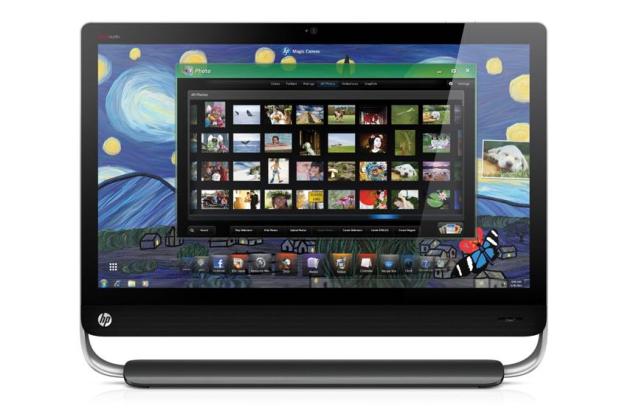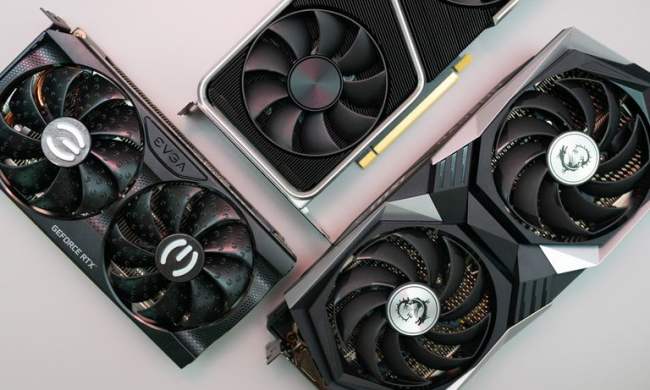
“HP’s TouchSmart line offers more functionality while the iMac is more powerful and more attractive. Given this competition, it’s hard to see where the big Omni fits.”
- Attractive design
- Large display
- Excellent audio quality
- Resolution is too low for the display’s size
- Limited video connectivity
- Poor performance
- Not a great value
What happens when an all-in-one escapes HP’s product laboratories and heads straight for the Cold Stone Creamery across the street? You end up with the HP Om-nom-nom … er, sorry. The HP Omni 27.
Yes, that’s right; this is a 27-inch all-in-one computer. It’s big and, at a base price of $1,199, it’s not particularly cheap. There are few manufacturers that make all-in-ones this large. Up until the introduction of Omni, only Apple and Asus had their feet in this plus-sized arena – and Asus’s entry has been so loosely marketed that we suspect most of the company’s employees are unaware of its existence.
HP is a different beast. It has taken the all-in-one seriously ever since the introduction of the original TouchSmart computers several years ago. Over time it has added more and more products, varying not just the hardware inside but also features and size. This particular model looks similar to the TouchSmarts we’ve tested in the past, but it doesn’t have a touchscreen – thus, the “Omni” branding.
Our review unit is equipped with a Core i5-2400S processor, 8GB of RAM and a 1TB hard drive. Discrete graphics options are available, but our unit relies on Intel HD 2000 to push the pixels. This means that our review unit is the base model – no extra options, no extra charges.
We’ve generally enjoyed HP’s all-in-ones in the past, but this is a real beast. Has it literally outgrown itself, or is there room in the lineup for a big daddy? Let’s find out.
Video overview
Hard to handle
The HP Omni 27 is one of the most unwieldy systems we’ve received, slotting in right behind high-end gaming desktops in size and weight. All-in-ones are allegedly supposed free up desk space, but the Omni instead consumes it. Its large and attractive metallic silver base keeps the computer sturdy but also ensures that the PC takes up as much room as possible.
Aesthetically, the Omni 27 is nearly identical to the smaller TouchSmart 520 that we reviewed a few months ago. The main difference is the display bezel, which on the Omni is flat edge-to-edge glass rather than raised plastic. This gives the all-in-one a premium look and feel, though Apple’s iMac remains the quality leader.
The main reason for this is the materials used by HP. Although the sturdy base seems to be largely constructed of metal, the rest of the chassis is plastic. This is most obvious in the silver trim used to accent the computer. It’s not entirely unattractive, but it feels a bit cheap. We’re sure the HP Omni 27 is plenty sturdy, but looks do matter, and the Omni isn’t up to the iMac’s high standards.
HDMI goes in, HDMI doesn’t come out
Our comparison to the TouchSmart 520 doesn’t end with the looks. Like that system, the Omni 27 offers a healthy dose of connectivity. You’ll find two USB 3.0 ports along the left side. They’re joined by four USB 2.0 ports along the back. Audio jacks are located both along the side and on the back. A 6-in-1 card reader rounds things out.

On the right side you’ll find an HDMI port. It’s HDMI-in only, however. You can connect other devices to the Omni 27 and make use of its display, but you can’t connect another display to the Omni 27. There are no other video inputs or outputs – DisplayPort, DVI and VGA are all absent.
There was no TV tuner on our review unit, but one can be added for $50. As with other HP all-in-ones, the TV tuner can be used by connecting a coax cable to the back of the computer.
Hands off
Given the similarities between the TouchSmart and the Omni, you may be wondering why HP has two different model lines. The difference comes down to touch.
The Omni line does not offer touch input either standard or as an option. If you want that, you have to buy a TouchSmart – though there’s no 27-inch TouchSmart available at this time.
In our opinion, the Omni actually makes more sense. The bright and glossy edge-to-edge display found on all of HP’s all-in-ones is more than capable of rendering media, but isn’t that well suited for touch use. Fingerprints easily show and the surface itself is a bit too slick to provide a proper tactile feel. In this case, less is more – taking away the touchscreen doesn’t deprive you of much functionality.
HP ships this PC with a pair of decent wireless peripherals. The thin, stylish keyboard isn’t a typist’s dream, but it will prove more than adequate for most users. The same goes for the two-button mouse with scroll wheel.
Fuzzy resolution
1080p resolution is standard on this PC. That sounds great, but it’s a rather mediocre resolution for a display of this size. Pixels are large and text does not look crisp as a result. This is most noticeable when browsing a website that uses a small font size or editing a document.
Of course, productivity usually isn’t the main focus of an all-in-one. They’re usually built with media use in mind, and that’s where the Omni 27 shines. Its big display makes the most of video no matter the source – YouTube, iTunes movies and DVDs all look great.
Beats Audio also comes standard, taking the form of stereo speakers and a built-in subwoofer. The TouchSmarts we’ve reviewed previously had good audio, but the Omni 27 is superior thanks to better bass and less overall distortion. Sound staging is poor – that’s a problem an all-in-one can’t avoid – but that’s the only issue we found.
Feeling bloated
The first piece of software that appeared when we booted the Omni 27 is HP’s Magic Canvas.
That’s a bit odd. HP Magic Canvas is the company’s custom software designed to make its all-in-ones easier to use via touch input. The Omni has no touch input, however – so why ship it with Magic Canvas?
Fortunately, dismissing the software requires no more than two clicks, so we were soon back to the Windows desktop. This revealed a (un)healthy diet of preinstalled apps and web shortcuts, many of which were for software and services we’d never heard of before. Though a bit distracting, all of these shortcuts are easy to delete.

More annoying is the anti-virus software. Norton is the poison of choice on this desktop. We don’t have any specific beef against the app’s ability to combat malware, but we do hate the constant pop-ups which display ads with ridiculous verbiage, such as “Congratulations! Your Computer Is Ready To Be Protected!”
Aw, shucks, Norton Anti-virus. Thanks. But we’d rather you just stop bugging users.
Big system, little speed
As mentioned, our HP Omni 27 review unit arrived with the base processor, a Core i5-2400S. The “S” might sound quick, but it in fact designates a processor that is slower than a normal Core i5. The reduction in performance keeps power use low. The processor comes with Intel HD 2000 graphics and is paired with 8GB of RAM.
In our CPU benchmarks, we found that the Core i5-2400S has similar performance to a Core i5 mobile processor. Its SiSoft Sandra Processor Arithmetic score was 49.43, which is just a few points better than the Core i5 we tested in the Lenovo ThinkPad T420s. The performance gap was a bit wider in 7-zip, where the Omni managed a combined result of 11,010. Still, this is a poor score for a desktop system.
PCMark 7 was kinder, returning a score of 2,736. This bests the HP TouchSmart 520 and the Acer Aspire M3 by a margin of a couple hundred points. It’s a victory that probably means more on paper than it does in reality, but a victory none the less.
Any enthusiasm to be gained from PCMark is quickly robbed by 3DMark 06, however. Our base model comes with Intel HD 2000 graphics – the entry-level IGP that has half the execution units of Intel HD 3000. This resulted in a score of 3,159, which is below – well, almost every other system we’ve recently tested besides the Lenovo Q180 nettop.
Still, the numbers don’t explain everything. Unlike the Q180, the Omni 27 has no problem with 1080p video. It is also a slightly better gaming system thanks to a significantly faster processor. Older 3D games will run, but newer games like Just Cause 2 and Battlefield 3 are out of the question.
All of this information comes with a caveat called Ivy Bridge, the latest revision of Intel’s microarchitecture. The new products will be coming to the Omni 27 in the form of the Omni 27qd, which will be available starting June 24. We expect to see a boost in overall performance with the new hardware – and HP is keeping the base price steady at $1,199.
Conclusion
HP’s new all-in-one is bigger, but is it better? We’re afraid the answer is no.
The larger display obviously costs HP more to acquire, and that cost is passed on to the user. A base price of $1,199 is far from outrageous – in fact, this is towards the less expensive end of the desktop systems we normally review – but it’s quite a lot for system that only has a Core i5-2400S processor. Ivy Bridge may address these concerns but, as tested, the Omni 27 is one of the slowest desktops we’ve had in our office over the past year.
Even the display isn’t a strong point. Yes, it’s large, but the display resolution is no higher than what’s found on smaller all-in-ones. The result is a reduction in perceived image quality. Apple’s iMac is clearly superior in this area.
The iMac is also a better overall value. The 27” version starts at $1,699 but comes equipped with a Core i5-2400 quad-core, Radeon HD 6770M discrete graphics and a resolution of 2560 x 1440. It’s not even possible to equip the Omni 27 with similar hardware. If you can swing the extra $500 (nothing to scoff at, we admit) the iMac provides you with more for your money.
We think the Omni 27-inch could be a good family computer – but it’s not the best family computer in any area. HP’s TouchSmart line offers more functionality while the iMac is more powerful and more attractive. Given this competition, it’s hard to see where the big Omni fits.
Highs
Attractive design
Large display
Excellent audio quality
Lows
Resolution is too low for the display’s size
Limited video connectivity
Poor performance
Not a great value


